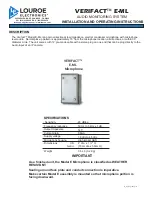
prisingly large, full drum sound.
For closer miking of a kick drum (10 to 18 inches), the micro-
phone should be leaned forward at a 45-degree angle to protect
the ribbon element from excessive plosive forces. This micro-
phone position also provides good kick drum isolation because
the top of the microphone, which does not pick up sound, is
aimed at the rest of drum kit.
Recording Loud or Plosive Sounds
With all ribbon microphones,
wind is the enemy!
Air movement
is far more damaging to ribbon microphones than high SPL’s.
Some sound sources can generate powerful blasts of air that
should be avoided. Kick drums and electric guitar and bass
amplifiers are typical examples of sound sources that can pro-
duce harmful air currents. One way to determine if the air pres-
sure is excessive is to place your hand in front of the sound
source (the kick drum, the guitar cab, etc.) and see if you can
feel actual air movement. If you feel air movement, do not put
your ribbon microphone there. A simple technique that can
avert damage due to overstressing the ribbon is as follows:
After choosing the optimum placement for the microphone,
slightly angle the microphone in such a way that the percussive
wave is not directed at the front of the mic “head on.”
Often, a
slight angular tilt (either vertically or horizontally) is all that is
required to prevent harm to the ribbon..
Example of the
Vertical
Positioning
Technique
Slight off-axis
positioning will
minimize stressing
the ribbon on loud
sound sources.
17
Содержание 122v
Страница 28: ...Polar Pattern Frequency Response 27 ...
Страница 29: ...Notes 28 ...
Страница 30: ...29 ...
Страница 31: ...30 ...
Страница 32: ...31 ...
















































